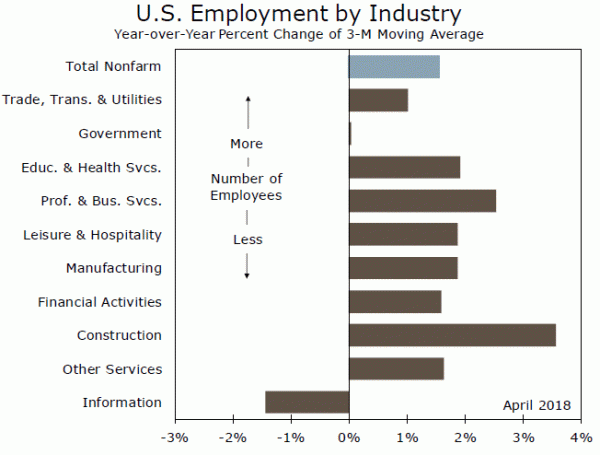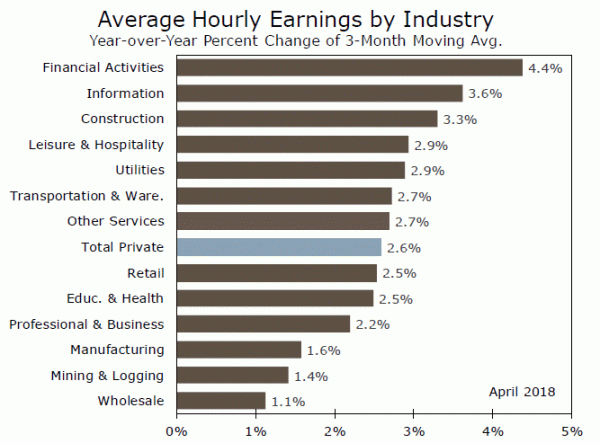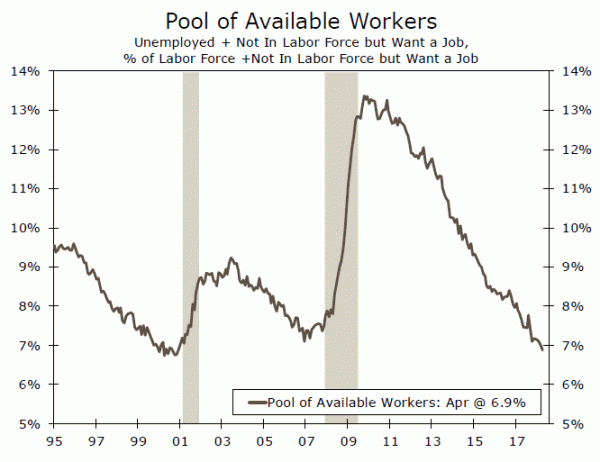April job gains came in at 164,000—below the three month average but enough to maintain momentum in a tight labor market as wages rise and the unemployment rate fell to 3.9 percent. Fed to raise rates in June.
Job Gains Broad-Based with April Jobs at 164,000
Nonfarm payrolls rose 164,000 in April with the three-month average at a solid 208,000 jobs. The broad-based character of the labor market is evidenced by the rise in the diffusion index to 64.0, continuing an uptrend since early 2016. Current job gains are consistent with 2.5-3.0 percent economic growth in the current quarter and an FOMC June rate hike.
Jobs gains appeared broad-based, with most sectors experiencing gains over the month (top graph). Manufacturing jobs continue to show upward momentum—up 24,000 in March and up an average of 26,000 over the past three months. Construction jobs also showed a gain of 17,000 and are up 25,000 on average over the past three months. Over the past three months, aggregate hours worked are up 2.6 percent, annualized, which is very solid and consistent with continued growth in personal income and consumption.
Diversity in Wage Growth -A Different Look
The theory that workers and employers respond to higher inflation is revealed in the rise in wages, consistent with the recent rise in inflation. However, there is a significant diversity in wage gains (middle graph). Not surprisingly, the service sectors of finance and information appear at the top. What is interesting is that the common perception of low-paid service jobs in leisure & hospitality show evidence of good gains over the past year. Also encouraging are the gains in earnings for construction workers. Last week’s Employment Cost Index report offered further support for the case that total labor compensation is showing good gains in a tight labor market.
Labor Market Slack Continues to Diminish
After six months at 4.1 percent, the unemployment rate broke through the four percent level and declined to 3.9 percent. That puts it at the lowest level in 18 years. The efficacy of the traditional unemployment rate as a measure of labor market slack has been questioned in the current cycle, given the substantial drop in labor force participation and higher rates of under-employment since the recession. While the headline unemployment rate continues to paint a brighter picture of the labor market, other measures point to the issue of slack largely disappearing in the labor market.
The share of workers employed part time but repot wanting full time work is nearly back to its pre-recession level. The total pool of available workers, which includes both the unemployed and workers not officially in the labor force but report wanting a job, has improved more substantially and is back to a rate not seen since before the 2001 recession (bottom graph). The dwindling rate of available workers suggests labor force participation may, as we saw in today’s report, struggle to rise unless greater opportunities and/or higher compensation can lure more workers into the labor market.



